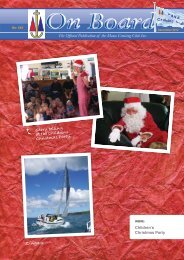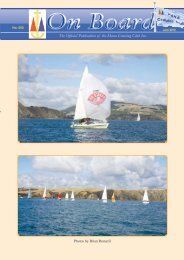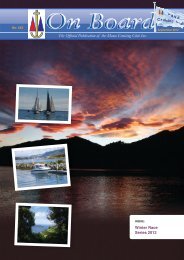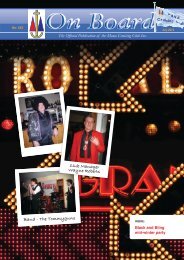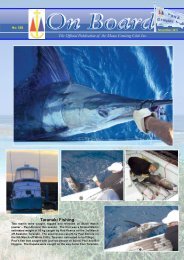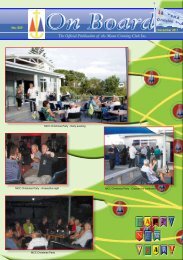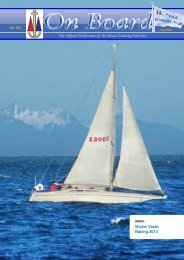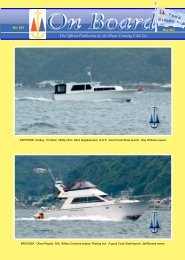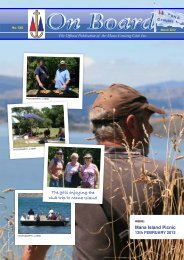The Night Train –“6 Days in a Leaky Boat”I thought you might like an account of our problems during the2-Handed Round North Island Race. As you will know by nowwe pulled out of the race on the second Leg from Mangonui toWellington. This was great disappointment to Dave Molen and I,given the huge effort we had put to getting ‘The Night Train’ racereadyand especially since we both knew that the conditions on Leg2 were really suiting us.To recap, we sailed TNT up from <strong>Mana</strong> a week before the race startand spent the time in Westhaven Marina ticking off the final list ofprep work. Conditions on the first leg from Auckland to Mangonuiwere not to our liking at all – we rarely had any more than thefaintest of winds and TNT struggled to get moving. It took us 6hours to ghost 2 miles around Cape Brett! What’s worse was that Idecided to leave my big overlapping Genoa at home (in my defenceI thought it would be a heavy weather race, and mostly downwind,so I went all out on the spinnakers, code 0 and gennaker). Thatone big headsail would have made a huge difference and I reallyregretted not having it. Dave said nothing when I told him!We had moments of yachting pleasure though, despite feelingunderpowered most of the time. The best section of Leg 1 was amidnight blast under a full moon from Cape Brett north past theCavalli Islands to Doubtless Bay. ‘Caro Vito’ had just about caughtus up at midnight as they brought up a growing breeze. At ourwatch-change Dave told me he thought they would pass us in a fewminutes, so we hauled out the Code 0 and unfurled it. TNT tookoff and we sped away from the big black boat. We never droppedbelow 8 knots in 10 knots of true wind, and managed to overtake11 boats in 6 hours (3 of which re-took us on the final mile to thefinish line as the wind died away – bugger!). This made up for allthe frustration earlier in the leg as we watched the lighter boats sailoff into the sunset.After a day’s break Leg 2 from Mangonui to Wellington started inghosting conditions again. We crept over the start line and veryslowly clawed across Doubtless Bay and up around the KarikariPeninsula. Wind was rarely above 5 knots and much of the time wewere parked up in holes. As we made ground up Great ExhibitionBay we had a nice sail alongside Dave Chalmers on ‘Vesper’ – thesun was out and all was well until I got a call from home on themobile to tell me the Christchurch earthquake had just struck. Thehorrific news rippled through the fleet and on TNT we were greatlyrelieved to know we had no close friends or family affected, and ourworkmates down there at the time were all safe.We (me, not Dave I should add) messed up this Leg from about halfway to North Cape. We had hooked into a nice northerly breeze andwe stayed heading offshore on port tack going well. The other boatswe were ahead of then tacked back towards the Northland coastmid afternoon. We didn’t. The breeze went more west – we werestuffed! The breeze then died altogether and we were left becalmed.We spent the rest of the next 12 hours trying to get back all the lostground and claw around Cape Reinga. It was early morning whenwe finally got past Cape Maria van Dieman and beat out into abuilding southerly.Dave was grinning from ear to ear now as we crashed through 2metre seas heading for Wellington. ‘The Night Train’ loves theseconditions and we were struggling to keep her from launchingherself off the waves and flying home. We were about 15 milesWest of 90 Mile Beach and doing a steady 7.5 knots hard on thewind. We had decided to make our first tack back towards the coastmid-afternoon to see what the opposite angle looked like, and to seewhat the angle to the swells would be like.Almost as soon as we tacked I went below to get some food. Whatgreeted me was the forward part of the boat full of water. Water wassloshing up the sides of the forward sole, lifting the floorboards upand down as we went through each wave. The water tasted salty soI presumed it was coming from somewhere forward. The forwardhead bilge and shower tray was full of water; the main bilge areawas full from the mast forward. We quickly set up our manualbilge pump (a big portable Edson) and pumped out as much of thewater as we could. We couldn’t find where the water was coming in.<strong>On</strong> the previous tack all was well we thought. We concluded thatsomething must have just broken. We considered it could be hulldamage (we were pounding off waves), or a through-hull had sprunga leak, or the keel joint was loose (we had a new keel installed 12months back). We never for a moment thought it could be waterfrom inside the boat – it tasted salty, so it must have come fromoutside, right?After ripping up the floorboards, and feeling round all the throughhulls and searching for a leak, we still couldn’t find where it wascoming in. At this stage there was still lots of water sloshing aroundbut it wasn’t flooding in. We had slowed the boat down and triedto keep things a bit less bumpy but the conditions were not helpingus.Dave and I talked over options. We were not sinking, but our nextsafe haven was New Plymouth and this was two days sail away,crashing into a building southerly and a nasty chop.I decided that this was not a prudent choice and we had no realoption but to turn around and head back up around North Capeand then down to the nearest shelter back in Mangonui to sort outwhat was wrong. This meant withdrawing from the race we hadspent the last 12 months preparing for, which was a very difficultpill to swallow.<strong>On</strong> the way back we pumped out another load of water as we wentround Cape Reinga and then had a very slow slog overnight backto where we had come from. I know Dave was as disappointed asI was during this time but he never once complained or questionedmy decision. However, we both felt lousy and were stuffed when wearrived back in Mongonui at daybreak. We dropped the pick andwent to bed.16
fitted the new keel they added an extra floor frame to support theslightly different keel shape. What they omitted was to put limberholes in it. A pool of water that had collected against this new floorframe but the water was stopped from flowing forward and downhillinto the main bilge area (where the main bilge pump is located).The water had to have come from somewhere aft of this new floorso I started tracking this down. It was brackish water. It had to beeither the engine cooling pipes, the aft-most water tanks (two), orthe hot water cylinder that tees into the engine heat exchanger.Later in the morning we awoke to a friendly call from a passinglocal in his dinghy. He had heard of our plight and had come overto offer us help. Graeme Moore was fantastic – Mangonui has a realpositive set of memories for us as a result of meeting Graeme. Hedid everything possible including inviting us for dinner and lendingus his dinghy and offering to arrange an urgent slip if we needed it.He really brightened up our flagging spirits.Anyway, the water level had not increased overnight so we pumpedthe boat completely dry and towelled out all the bilges and startedour hunt for the leak.At this stage we still thought it was most likely to be either damageto the hull or a pressure leak in a corroded through-hull. The idea itcould be the new keel we thought was possible but unlikely.To cut a very long story short we spent the next three days rulingout things, rather than finding the source. We dived under the boatto check for damage. It was fine as far as we could see. We wentfor test sails to check for high pressure leaks in the though-hulls.We couldn’t even reproduce the leaks on the open water sail southto the beautiful Whangaroa Harbour. At Whangaroa we met upwith Nikki and Doug on ‘Karie-L’. It was great to see them bothand Doug dived with me to check out the keel again. We foundnothing wrong.It was about this point that I started to suspect it could be freshwater so I dismantled the furniture to get access to the most likelytanks (we have 3 separate tanks). I thought I could see a small holein one of the corners of one tank but this tank was almost emptyat this stage, so it was difficult to test this theory, but it soundedplausible.Next day we headed down to Kerikeri as Dave had to get a flighthome. My plan was to fill up the water tanks there and check forleaks. Dave left for the airport. I carried on looking.The next day I found a clue. When the guys at Lloyd StevensonsIt took another day to isolate it to a leaking hot water cylinder, butwhat I need to understand was how this relatively small amount ofwater (I reckoned about 3 gallons) could build up into so muchup forward. Water was running out of the cylinder whenever theengine was running. It would run down from the hot water cylinderand end up against the new floor frame and sit there until we wereheeling over. If we heeled to starboard it flowed around the newfloor frame and ran into the main bilge area normally to be pumpedout with general bilge water (we get some running the inside of themast when it rains).However if we heeled to port it would work its way forward past thecollection area and under some circumstances (high angles of heeland lots of pitching) can get ‘stuck’ in three big pooling areas of theforward bilge to starboard. A contributing factor to what happenedwas that one of the limber holes up forward was also blocked. Daveand I found this when we were drying out the bilges early on butwe didn’t get the significance of it at the time. This blockage waspreventing any bilge water that did run forward from running backaft again.All this resulted in the leaking water from the hot water cylinderaccumulating in the hidden sections of the bilge on the starboardside and building up volume there until it all flowed over the lastframe under the mast and into the forward head where it built upsome more (we don’t use this head at sea so we didn’t notice it) andthen over the door sill into the forward most bilge where it got stuckdue to the blocked limber hole. That’s where I first saw it!In all likelihood the amount of water I saw had built up quietlyin the hidden bilge area for several days from when the hot watercylinder started leaking. It just took the increased heel and pitchingto move it out of its collection areas and over the floorboards.So, there you are. A simple leak that confused the hell out of usand ruined our race. Why was it salty? Probably because it swilledaround in the salty bilge. It tasted like salt water to me, but it wasprobably just brackish and I jumped to the conclusion that tastingsalty meant it was sea water. If I had made the distinction we mayhave been content to keep going and our race would have had amuch different ending.‘The Night Train’ is now resting peacefully for us in Kerikeri Marina.We are looking forward to the next RNI race and some unfinishedbusiness.....Mike McDermott17



